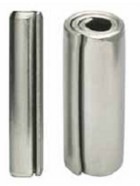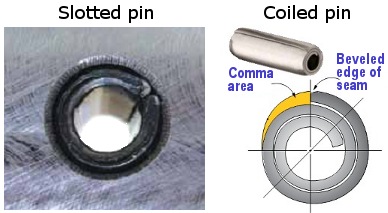 |
| August 28, 2018 | Volume 14 Issue 32 |
Designfax weekly eMagazine
Archives
Partners
Manufacturing Center
Product Spotlight
Modern Applications News
Metalworking Ideas For
Today's Job Shops
Tooling and Production
Strategies for large
metalworking plants
Engineer's Toolbox:
Fasteners: Clever seam design makes coiled pin perfect for hinges
By Michael Pasko, Engineer, SPIROL International Corporation, Danielson, CT

Figure 1. Left, slotted spring pins have a "C" shape. Coiled spring pins (right) have 2 1/4 coils of rolled material.
Coiled spring pins are manufactured with a seam that is much better for hinges than the gap or slot of slotted spring pins (see Figure 1).
The seam is inherent to coiled pins because they are rolled with more than one wrap of material. The coiled pin's "duty" will affect material thickness and the number of wraps, but all coiled pins will possess a seam.
Some assume that a coiled pin's seam is raised above the surface of the pin. This is not the case. A coiled pin's seam is actually "tucked" or rolled to ensure the pin remains round. In addition, the seam is prepared with a beveled edge to soften the transition into the "comma" area (see Figure 2). As a matter of fact, a key characteristic of a properly rolled coiled pin is that the diameter of the pin at the seam is equal to or less than the diameter adjacent to the seam. This prevents the edge of the material from contacting the inside diameter of the hole wall to head off skiving when inserted.

Figure 2. The slotted pin's gap (left) is closed when installed in a hole. The coiled pin's seam is prepared with a beveled edge to soften the transition into the 'comma' area. This design feature ensures that there are no "high spots" at the seam.
The plastic SUV rear window latch assembly photo below (Figure 3) demonstrates basic coiled pin form when installed in an application. The pin conforms to the hole in which it is installed, and the comma area is visible as a small gap between the pin and hole adjacent to the seam.
A large percentage of coiled pins are used in hinges, and the unique seam configuration is essential to their proper function. Thus, when utilized in round holes, the seam should have absolutely no impact on performance.

Figure 3. This SUV rear window latch assembly utilizes three coiled pins as hinges.
The coiled pin's tucked seam will allow smooth, interference-free rotation of hinge/axle components in the vast majority of assemblies. In most situations where the seam is problematic, it is typically the result of poor installation methods or improper implementation. If excessive compressive force is applied to one part of the pin and not another, seam deformation may occur. This sometimes happens when assemblies are designed such that they do not properly support the pin.

Figure 4: Coiled Pins are often used as hinge pins in durable consumer products, as demonstrated in this toilet-float arm assembly.
Similarly, pins can be damaged during installation, and this can lead to deformation at the seam. Improper installation technique, equipment, hole condition, or pin material and duty are typical causes. Designers have also attempted to use coiled pins and slotted pins in assemblies where a "pawl" or lever must ride on the surface of the pin as it rotates. The geometry of these components sometimes causes them to catch or hang up on the seam.
SPIROL's application engineering team will evaluate all assemblies to determine what type of pin would best meet the specific hinge requirements. Engineers can start the process by selecting "pinning applications" in SPIROL's Optimal Application Engineering portal.
For more information, go to www.spirol.com.
Published August 2018
Rate this article
View our terms of use and privacy policy
